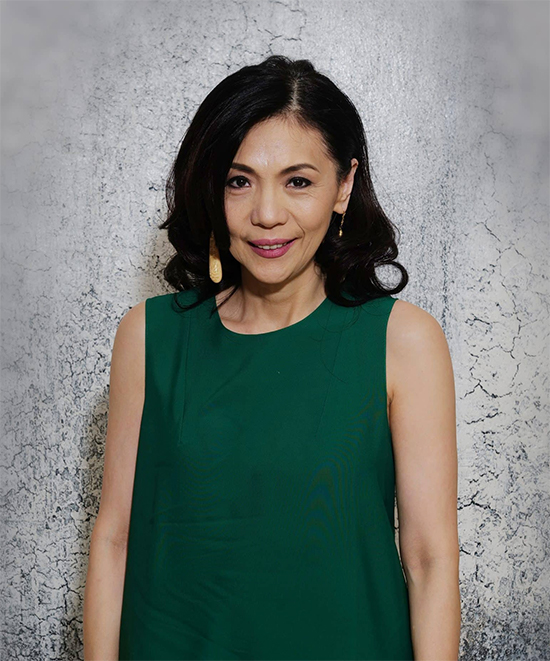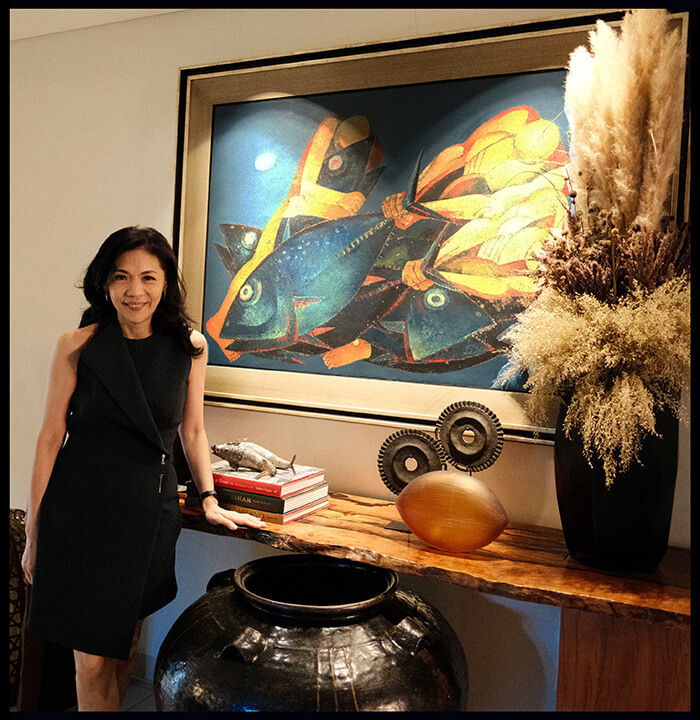Kaye Tinga: ‘The CCP is more than just a building; it is a brand, a living entity.’
Who would’ve thought that in our lifetime we’d have a Cultural Center of the Philippines (CCP) president who not only loves the opera and Ang Kiukok, but also digs Billy Joel and the Eagles, and is, by profession, a hands-on entrepreneur and, at heart, a philanthropist?
Meet Kaye Tinga, who hit the ground running once she assumed the leadership of the CCP last June.
“The first thing I did was to talk to all the departments and was amazed by the breadth of what CCP does, not just in the areas of visual and the performing arts; you have education, outreach programs, and cultural content,” she explains. There are also training activities for teachers and initiatives to teach indigenous dance.”
Tinga is the co-founder and co-chair of the Red Charity Gala, a prestigious annual event that aims to celebrate local fashion through the works of renowned Filipino designers. The gala also raises substantial funds for charitable causes, including for the Philippine Red Cross.

A business economics graduate from the University of the Philippines (UP) Diliman, with an MBA from Fordham University, she is the co-founder and managing director of W/17, a home furnishing and accessories brand that collaborates with craftsmen from various regions across the Philippines, including from Cebu, Cavite, Pampanga and Dumaguete. Through her leadership, her brand has been promoting local artisans, cultural skills preservation, and economic development. Kaye started a new phase in her life when the CCP board of trustees elected her as president.
As the CCP main building undergoes rehabilitation, Kaye Tinga says they have to think outside the box by staging events in other venues, renting theaters, and doing outreach performances. The CCP, after all, is a dynamic, living space.
“The CCP is really more than just a building; it is a living entity that encompasses everything about art and culture in our country.” When Kaye attended St. Scholastica’s College Manila in high school, she passed by the CCP every day and was impressed with the edifice with signs heralding ballet, opera or theater performances. “The iconic building caught my attention,” she recalls, “but I started wondering what’s going on inside.”
Decades later, not only has Kaye found herself inside the walls of the brutalist icon, but is situated at its nerve center and tasked with steering it into a bolder, more interesting age and growing its audience. What strengths does she bring in her new role as the leader of an institution at the forefront of promoting and preserving the best of Filipino creativity?

“Firstly, the CCP is about people. It’s an organization with over 300 employees. What is important for us is to work as a team. Our mandate is clear, but, at the same time, we have so many programs, responsibilities. That’s why it is essential to be able to manage it. And, with my own experience as a banker, an entrepreneur, what I’m doing now is to put all these things together in an organized, methodical manner.”
It is an artistic institution, all right. And yet, a passion for the arts may not be enough to pull the job off when the times call for more of a managerial mind. “We do a lot of linkages with private corporations, the diplomatic corps, and other government bodies. So that really takes a lot of my time. And it forces me to be more creative in how we can work with the private sector. With my experience with the Red Charity Gala, you don’t just need sponsors, you need partners.”
But Kaye becomes really animated when you talk to her about art. Clearly, the woman lives and breathes creative content.

“Art is all about perception and viewpoints, lessons you get when you watch The Sixth Sense, with its unreliable narrator, or read the controversial Lolita. When my peers were gushing over Rob Lowe and Andrew McCarthy back in the day, I was into Humphrey Bogart, Montgomery Clift and Clark Gable, who had so much swagger. My mom, Petra Chua, loved old music and movies. My Fair Lady was the first movie I remember watching.”
When Kaye was studying at Fordham in NYC, her roommates were students at Juilliard: a pianist, a violinist, a French horn player, and a trombonist. “They regularly practiced in our apartment. Thankfully, not the trombone player, though—it wasn’t allowed (laughs). So I had instant concerts. One time, the members of the New York Philharmonic Orchestra went on strike and were playing on the streets. Those were key moments of my life.”
Nowadays, Kaye has parallel experiences working for the CCP. “I walk into our office, which is in the annex, kind of makeshift, and you’ll see and hear people practicing on the piano. I’m very blessed to be exposed to that.”
She loves figurative works by Ang Kiukok, but she also gravitates towards the more inscrutable abstractionists such as Lao Lianben. “I like to be able to interpret, to think on my own, and have my own thoughts on particular artworks.”
Kaye continues on how art encourages critical thinking. “Literature and the arts teach you that what you see is not what you get. A lot of times, people will just believe what they hear. Maybe that’s what’s lacking (in our educational system) because we don’t really teach the arts at an early level. We’re very lucky to have President Bongbong Marcos. You know that he grew up exposed to the arts and he really understands how important it is in a society. And that’s why we’ve been given a lot of support. And we’re really looking at CCP to be able to promote the Philippines as an international hub for performances.”
Another Singapore or Hong Kong, perhaps? But since the hub itself is undergoing major renovations (to be completed in 2026), alternative venues are being utilized, such as the Metropolitan Theater, Samsung Performing Arts Center, and The Theatre At Solaire. Outreach performances also have been held at the far edges of Visayas and Mindanao.
“The Philippine Philharmonic Orchestra (PPO) recently performed in Biñan, Laguna, for the fiesta. At first, they played Bach, Schubert and Mozart; then it was movie and Broadway themes; later on, they were doing OPM tunes. The crowd was on its feet, dancing and singing along.” Imagine people in far-flung provinces, in plazas and basketball courts, hearing the heavens unfasten to the strains of Ludwig or Johann, and then afterwards grooving to the sounds of, say, Rock Baby Rock. These versatile musicians of the PPO also did a recent concert of K-drama theme songs (Crash Landing on You, Goblin, etc.).
The CCP executive mentions their Balagtasan program. “We do it in places such as, for example, Capiz and people really do turn up. We’re doing this in a way that people don’t forget (our cultural touchstones), young people especially. Art and culture are not just for the elite. The CCP is for everybody.”
She also mentions the institution’s scholarship programs for their musicians. Under the CCP Young Music Scholars initiative, deserving ones are being sent to study in the UK or US. Their stories are quite touching, informs Kaye.
Flutist Mark Kennedy Rocas grew up in a really austere environment and did not have toys to play with. He remembers hearing the marching band pass by their house in Cavite and being drawn to the music as a nine-year-old boy. He found a flute in their house and started playing it. That was the first movement of what is becoming a remarkable life, as Rocas, a CCP scholar, is currently finishing his master’s in flute performance at Bard College in NYC.
Another scholar, soprano Lizzie Bett Estrada, is studying at the Royal Academy of Music in London.
Kaye reveals, “I asked Lizzie how she started. And she answered, ‘I like to do karaoke…’ (laughs). ‘To sing Celine Dion.’ Amazing talent! She was so lucky to be able to encounter a teacher who encouraged her to apply to the Philippine High School for the Arts. Six years later, she’s doing this. Those are heartwarming stories.”
With these stories of artistic triumphs by Filipinos with humble beginnings and the common folk in barrios hearing Beethoven performed by an orchestra for the first time, it made Kaye Tinga realize how there is a need to value CCP as a brand.
“It is really a prestigious one. We’re an arts institution. We need artistic freedom. But, first, we should run things the right way. (As an individual) I don’t really seek out that kind of attention. But since we’re rebuilding the CCP and if I can represent the institution, expand our audience and grow our profile, then I’m out there.”



